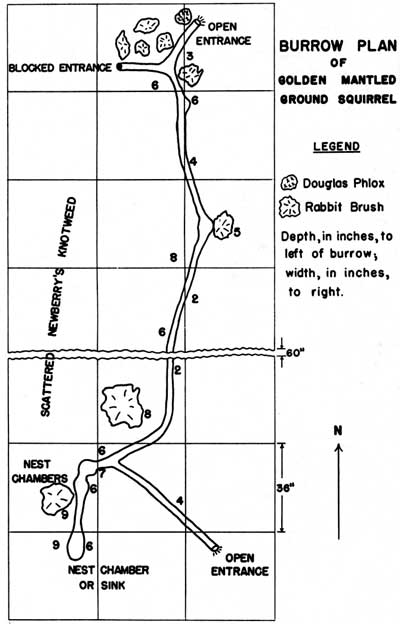|
THE GOLDEN MANTLED
GROUND SQUIRREL
by Ralph R. Huestis
Special Number - 1951
The Golden-Mantled Ground Squirrel In Crater Lake National Park
(continued)
By Ralph R. Huestis
DOMESTICATION
A certain number are captured and kept successfully as pets, often
living for several years according to the testimony of Park visitors who
have kept them. This is presumably due to their being able to thrive on
the diet usual for the commoner domestic pets and to stand overfeeding.
They hibernate in captivity even in the relatively warm Willamette
Valley. During the winter of 1937-38 Professor Milne, of Oregon State
College, kept two female squirrels in a nest box in his yard at
Corvallis. Both squirrels hibernated, "rolled in a ball" with their
heads between their fore limbs. They were cold to the touch and promptly
resumed the hibernating posture if forcibly unrolled. They could be
gradually aroused if put out in the sun and would attempt to bite if
they were touched during this interval. During the warmth of the day
they would remain active but would resume hibernation again that night
and remain asleep unless again disturbed. Quite contrary to what is
usually assumed, the smaller, thinner squirrel remained in hibernation
two or three weeks after her bigger sister had emerged. Neither squirrel
appeared to have lost weight during the hibernating period. Squirrels
emerging from winter quarters at Crater Lake in 1937 and 1938 were all
in good condition also.
Three burrows were dug out in August 1937 to study the plan of
construction. Two were empty (abandoned?) and one, herewith reproduced,
contained a squirrel. He hung around awhile during the excavating
process and regarded the operation with some concern.

The burrow which has been reproduced was the shortest and simplest
of the three, being rather less than thirty feet in length. The longest
tunnel was more than a hundred feet in total length, tortuous and
containing cross connections. The third burrow was forty feet in length.
Tunnels were usually about six inches below the surface, the greatest
depth being reached in a cul-de-sac ten inches deep, either a nest
chamber or sink. No tunnel contained nesting material. Diameters varied
from two to four inches. Turn-arounds and nesting sites or sinks were
from five to seven inches in diameter. All tunnels contained more than
one open entrance, with one or more blocked with earth.
Tunnels went under rocks and the roots of bushes when these were
encountered but entrances were not necessarily hidden. In general one
might say that the tunnels were like the squirrel, rather simple and
direct.
LITERATURE
Bailey, Vernon. 1936. Mammals and Life Zones of Oregon. North
American Fauna No. 55. U.S.D.A. Bureau of Biological Survey.
Gordon, K. 1943. The Natural History and Behavior of the Western
Chipmunk and Mantled Ground Squirrel, Oregon State Monograph Studies in
Zoology No. 5.
Grinnell, J. and T. I. Storer. 1924. Animal Life in the Yosemite,
California University Museum Vertebrate Zoology Contribution, California
University Publications of Zoology.
| 
